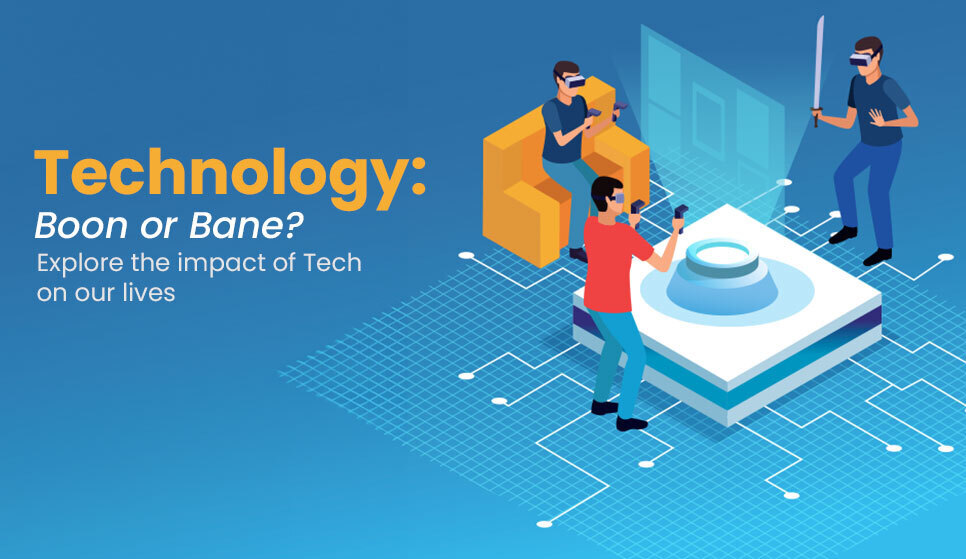VVN, recognised as one of the best CBSE schools in Rajound, excels in academics and sports facilities and focuses on teaching students how to use technology responsibly for learning and personal growth.
Introduction
Technology plays an integral role in our daily routine- imagine waking up, and without you lifting your finger, your coffee machine starts brewing your favourite coffee.
Or your thermostat adjusts to the perfect room temperature, and your phone greets you with a reminder about your tasks. Sounds like magic, right?
This is the reality we live in technology has made our life easier, faster and more convenient than ever. From the moment we wake up to the time we go to bed, technology is deeply embedded in our routines.
But here’s the big question: Are we becoming too reliant on technology or is it improving our lives? Is it a boon- a blessing to make our lives better, or a bane curse that brings unforeseen consequences?
Let’s deep dive into this blog to explore both sides of the argument, helping you decide where you stand in the class debate of technology’s role in our world.
What is Technology?
Let’s understand first: What exactly is technology? It refers to the tools, machines, and systems we develop to solve problems, complete our tasks and create new possibilities.
It has evolved drastically over the period from the humble wheel to cutting-edge intelligence.
The evolution of technology at lightning speed has helped us carry heavy loads to now diagnose diseases, weather predictions, solve complex problems and connect to our loved ones in any part of the world.
It's so ingrained in our daily lives that it’s hard to imagine a world without it. Think about it: What would you do without your phone? How would you learn, shop, or communicate? Technology has become an undeniable part of human progress.
The Boon Side of Technology
To start with the boon side`, let’s explore how it has made our world easier, more connected, more exciting and more convenient:
1. Revolutionizing Communication
From handwritten letters to touchpad phones, we as humans have observed communication has changed drastically in the last decade.
You want to video call your cousin in the US without paying a hefty amount and it is possible with a click.
Get your groceries delivered in 10 minutes or ask an AI assistant to solve your problems.
This interconnectedness has transformed not only personal relationships but also how we work, collaborate, and do business. It’s a global village, and technology is the glue holding it together.
2. Advancements in Healthcare
Haven’t we read stories of our ancestors/relatives not being able to reach out to doctors when needed the most?
Imagine the situation where there is no access to basic healthcare facilities and no consultation. In the past, this might have been a big problem.
But now, thanks to telemedicine, you can consult a healthcare professional online, receive a diagnosis, and even get prescriptions—all from the comfort of your home.
There’s more- AI-powered diagnostics, robotic surgeries and 3-D printed prosthetics which is reshaping the healthcare industry to the next level.
This has helped to save millions of lives, treatments becoming more precise and access to healthcare is improving globally.
3. Enhancing Education and Learning
Gone are those days of textbooks and taking notes by hand–Well, the digital age has flipped the script. Thanks to online learning platforms, video lectures, and interactive tools, education has never been more accessible or dynamic.
Numerous online courses have opened up a world of learning opportunities to people across the globe. You can learn a new language from a professor in Paris by simply sitting in your living room. The possibilities are endless, and the best part?
It’s all available at your fingertips. You can check out the use of online platforms and learning in
4. Boosting Economic Growth
We talked about individual benefits, but technology has been a massive job creator. From tech startups to digital marketing, the digital revolution is booming.
Automation has improved productivity, while digital platforms have allowed businesses to scale globally.
Additionally, industries like e-commerce and app development are creating new job opportunities and reshaping the traditional workforce.
Technology is the driving force behind much of the world’s economic growth—and it’s showing no signs of slowing down.
5. Making Life Convenient
Technology facilitates daily life by streamlining tasks and conserving time. Technology can help in many aspects, instants are mentioned below:
- Education & Learning: Platforms such as Coursera, Khan Academy, and Duolingo provide courses, tutorials, and skill-building resources.
- Health & Fitness: Apps like MyFitnessPal and Fitbit track physical activity, monitor health metrics, and offer workout routines.
- Navigation & Travel: Apps like Here Comes the Bus and Safetrax provide real-time school bus tracking for student safety and real-time traffic updates.
- Parental Engagement: Apps such as ClassDojo and Seesaw facilitate communication between teachers and parents, keeping them updated on student performance and activities.
- Time Management: Tools like Todoist and Forest assist students in managing their time and staying focused on tasks.
The Bane Side of Technology
Excessive technology use diminishes physical activity, weakens social bonds, and harms mental well-being. It disrupts sleep and focus, necessitating a balanced approach.
1. Addiction and Overdependence
Addiction and overdependence on technology among students have become growing concerns.
Constant use of devices for entertainment, social media, and even learning can lead to reduced face-to-face interactions and physical activity.
This dependence can negatively affect students' mental health, causing stress, anxiety, and sleep disturbances.
Students need to manage their screen time effectively and balance their online and offline activities for better overall well-being and academic success.
2. Cybersecurity Threats
With the increased use of technology, students are more vulnerable to cybersecurity threats, such as hacking, identity theft, and online scams.
Many students unknowingly share personal information on social media or use weak passwords, making them easy targets for cybercriminals.
Cyberbullying is also a significant issue, with harmful messages and malicious content affecting students' mental well-being.
As students spend more time online for learning, gaming, and socializing, it’s essential to prioritize online safety.
Simple steps like using strong passwords, being cautious of phishing attempts, and respecting privacy can go a long way in protecting against these threats.
3. Impact on Social Relationships
Excessive use of technology can significantly impact a student's social relationships, leading to weaker face-to-face interactions.
Spending more time on screens often means less time engaging with family, friends, and peers in meaningful, in-person conversations.
This can result in feelings of loneliness and isolation, as digital communication lacks the emotional depth of real-world interactions.
Additionally, students may become more focused on virtual validation, like likes and comments, which can harm their self-esteem and cause unnecessary stress.
Balancing technology use with real-life connections is essential for fostering healthy, supportive relationships.
4. Environmental Concerns
The increased use of technology in students' lives contributes to growing environmental concerns, primarily due to the energy consumption and e-waste associated with digital devices.
Devices like laptops, smartphones, and tablets require significant energy to manufacture, operate, and dispose of, leading to carbon emissions and environmental degradation.
The constant upgrading of gadgets also results in vast amounts of electronic waste, which often ends up in landfills, harming ecosystems.
Students can play a role in reducing their environmental impact by recycling old devices, using energy-efficient products, and minimizing unnecessary screen time.
Embracing sustainable practices is essential to mitigating the environmental effects of our digital lifestyles.
5. Loss of Privacy
Excessive use of technology can lead to a significant loss of privacy for students, as personal information is often shared or stored online without fully understanding the risks.
Social media platforms, apps, and online learning tools collect vast amounts of data, which can be misused or accessed by unauthorized parties.
Students may unknowingly expose themselves to cyber threats, such as data breaches or identity theft, by sharing sensitive details or using weak security settings.
Maintaining privacy requires students to be mindful of what they share online, use strong passwords, and regularly review privacy settings on their digital devices and accounts.
Striking a Balance Between Boon and Bane
Striking a balance between the boon and bane of technology is essential for students to harness its benefits while avoiding its potential drawbacks.
1. Setting Boundaries
Setting boundaries for technology use in daily routines is crucial to maintain a healthy balance.
Here are some points to consider for setting boundaries.
- Set Time Limits: Establish specific time frames for using technology, such as 30 minutes for social media or gaming, and stick to them.
- Designate Tech-Free Zones: Create areas in your home, like the dining table or bedroom, where no devices are allowed to encourage social interaction and rest.
- Turn Off Notifications: Disable non-essential notifications to reduce distractions and maintain focus on important tasks.
- Use Technology for Productive Purposes: Limit screen time to educational, work, or productivity-related tasks and avoid mindless scrolling.
- Sleep Without Devices: Keep your phone and other devices out of the bedroom to improve sleep quality and avoid nighttime distractions.
2. Cyber Awareness
Educate students about the risks of sharing personal information online and the importance of strong passwords.
Provide parents with resources to monitor their children's online activities, such as using parental control software and setting device time limits.
Encourage responsible social media use and remind them of the long-lasting impact of their online actions.
3. Responsible Innovation
Responsible innovation plays a crucial role in striking a balance between the boon and bane of technology.
It encourages the development of new technologies that not only drive progress but also consider their potential social, ethical, and environmental consequences.
By focusing on responsible practices, innovators can ensure that technology enhances lives without causing harm or deepening inequalities.
This approach helps mitigate risks such as privacy breaches, environmental degradation, and misuse, fostering a future where technological advancements are aligned with the greater good.
Ultimately, responsible innovation ensures that the benefits of technology are maximized while minimizing its negative impacts.
How do the best schools in Rajound like VVN guide in effective use of technology?
Schools play a vital role in helping students strike a balance between the boon and bane of technology. Here are a few ways through which VVN guides the students.
- Digital Literacy Programs:For the benefit of students top CBSE-affiliated schools near Rajound like VVN have introduced digital literacy courses that teach students how to use technology effectively while understanding its cons. This program included lessons on internet safety, recognizing misinformation, and managing screen time.
- Promoting Offline Activities: By organizing extracurricular activities such as sports, arts, and outdoor events, VVN has always encouraged students to engage in real-world experiences and reduce their dependency on technology for entertainment.
- Encouraging Mindful Tech Use: Our teachers and school counsellors can help students develop mindful habits, such as limiting social media time, prioritizing face-to-face communication, and setting "tech-free" hours for rest and reflection.
- Parent and Teacher Collaboration:Our School involves parents and teachers in creating a supportive environment for students to balance technology use. Workshops and meetings are held to provide parents with strategies to manage screen time at home and promote healthy online behaviours.
- Providing Emotional and Social Support: VVN offers counselling services to support students dealing with the negative effects of technology, such as cyberbullying, social isolation, or addiction, ensuring that they have the resources to manage these challenges.
Conclusion
In conclusion, technology has undoubtedly transformed our daily lives, offering unprecedented convenience, connectivity, and access to information.
However, its overuse and dependence can lead to negative consequences such as social isolation, privacy concerns, and mental health issues.
Striking a balance between the boon and bane of technology is essential to harness its benefits while mitigating its risks.
By setting boundaries, promoting responsible use, and encouraging offline engagement, we can ensure that technology remains a positive force in our lives.
With mindful practices, we can enjoy the advantages of technology without letting it overwhelm or harm our well-being.


